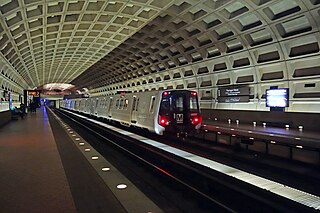
The Washington Metro, often abbreviated as the Metro and formally the Metrorail, is a rapid transit system serving the Washington metropolitan area of the United States. It is administered by the Washington Metropolitan Area Transit Authority (WMATA), which also operates the Metrobus service under the Metro name. Opened in 1976, the network now includes six lines, 98 stations, and 129 miles (208 km) of route.
Landover is an unincorporated community and census-designated place in Prince George's County, Maryland, United States. As of the 2020 census, it had a population of 25,998.
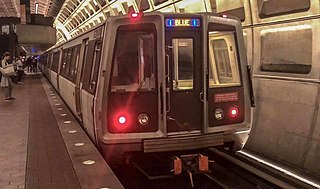
The Blue Line is a rapid transit line of the Washington Metro system, consisting of 28 stations in Fairfax County, Alexandria and Arlington, Virginia; Washington, D.C.; and Prince George's County, Maryland, United States. The Blue Line runs from Franconia–Springfield to Downtown Largo. The line shares track with the Orange Line for 13 stations, the Silver Line for 18, and the Yellow Line for 7. Only 3 stations are exclusive to the Blue Line.

The Orange Line is a rapid transit line of the Washington Metro system, consisting of 26 stations in Fairfax County and Arlington, Virginia; the District of Columbia; and Prince George's County, Maryland, United States. The Orange Line runs from Vienna in Virginia to New Carrollton in Maryland. Half of the line's stations are shared with the Blue Line and over two thirds are shared with the Silver Line. Orange Line service began on November 20, 1978.

Ballston–MU station is a side platformed Washington Metro station in Arlington County, Virginia. The station opened on December 1, 1979, and is operated by the Washington Metropolitan Area Transit Authority (WMATA). The station is part of the Orange and Silver Lines and serves the transit-oriented community of Ballston, Ballston Quarter, and Marymount University (MU).

Federal Triangle station is a Washington Metro station in Washington, D.C., United States. The island-platformed station was opened on July 1, 1977, and is operated by the Washington Metropolitan Area Transit Authority (WMATA). Providing service for the Blue, Orange, and Silver Lines, the station's entrance is beneath the William Jefferson Clinton Federal Building.

Stadium–Armory station is a Washington Metro station in Southeast, Washington, D.C. It is located at the border of the Barney Circle and Kingman Park neighborhoods. The station was opened on July 1, 1977, and is operated by the Washington Metropolitan Area Transit Authority (WMATA). Stadium–Armory serves the Blue, Orange and Silver Lines. It is a transfer station, as this is the last station shared by the three lines before the lines diverge going east; east of the station, all three lines rise above ground onto elevated track to cross the Anacostia River. At the diverge point, the Orange Line continues above ground veering northbound towards the Minnesota Avenue station, and the Blue and Silver Lines continue eastbound entering a tunnel towards Benning Road.
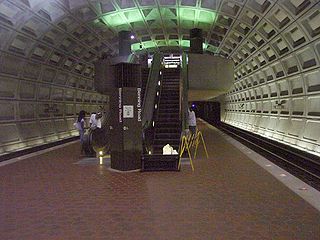
Benning Road station is an island-platformed Washington Metro station in the Benning Ridge neighborhood of Northeast Washington, D.C., United States. The station was opened on November 22, 1980, and is operated by the Washington Metropolitan Area Transit Authority (WMATA). Providing service for the Blue and Silver Lines, the station is located in a residential area near the intersection of Benning Road and East Capitol Street. It is the first station after the Blue and Silver Lines diverge from the Orange Line east of the Anacostia River, and also the last station in the District of Columbia going east.
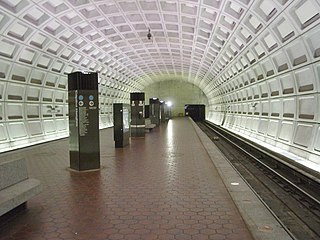
Capitol Heights station is an island-platformed Washington Metro station in Capitol Heights, Maryland, United States. The station was opened on November 22, 1980, and is operated by the Washington Metropolitan Area Transit Authority (WMATA). Providing service for the Blue and Silver Lines, the station is located at 133 Central Avenue in a residential area at East Capitol Street and Southern Avenue SE. This is the first station on the two lines in Maryland going east. As of 2017, in terms of weekday average boardings, it is the least used underground station in the system and the 10th least used station overall.

Addison Road station is a rapid transit station on the Washington Metro's Silver and Blue Lines. It is operated by the Washington Metropolitan Area Transit Authority, who opened it in 1980. It was the eastern end of the Blue Line until 2004. The station is in Seat Pleasant on Central Avenue, although its official address puts it in Capitol Heights.

Downtown Largo station is an island-platformed Washington Metro station in Lake Arbor, Prince George's County, Maryland, United States, with a Largo postal address.

Minnesota Avenue station is an island-platformed Washington Metro station in the Central Northeast/Mahaning Heights neighborhood of Northeast Washington, D.C., United States. The station was opened on November 20, 1978, and is operated by the Washington Metropolitan Area Transit Authority (WMATA).

Deanwood station is an island-platformed Washington Metro station in the Deanwood neighborhood of Northeast Washington, D.C., United States. The station was opened on November 20, 1978, and is operated by the Washington Metropolitan Area Transit Authority (WMATA). Providing service for only the Orange Line, the station is the final station in the District of Columbia going east. The station is located at Minnesota Avenue and 48th Street Northeast.

Cheverly station is a side-platformed Washington Metro station in Prince George's County, Maryland, United States. The station was opened on November 20, 1978, and is operated by the Washington Metropolitan Area Transit Authority (WMATA). Providing service for the Orange Line, the station is the first station going east in Maryland on the Orange Line. The station is in the residential area of Cheverly at Columbia Park Road near U.S. Route 50. It is a commuter station with 530 parking spaces. In 2021, Cheverly had the lowest average weekday ridership of any Metro station. When Phase 2 of the Silver Line was released in 2022, this was no longer the case as Loudoun Gateway had an even lower average weekday ridership.
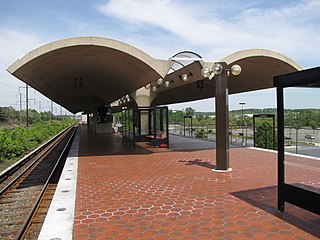
Landover station is an island-platformed Washington Metro station in Landover, Maryland, United States. The station was opened on November 20, 1978, and is operated by the Washington Metropolitan Area Transit Authority (WMATA). Providing service for the Orange Line, the station is in a residential area of Landover at Pennsy Drive near Landover Road. It is primarily a commuter station, with parking for over 1,800 cars, but it also served the now-demolished Capital Centre, the former home of the Washington Bullets and Washington Capitals.

New Carrollton station is a joint Washington Metro, MARC, and Amtrak station just outside the city limits of New Carrollton, Prince George's County, Maryland located at the eastern end of the Metro's Orange Line. The station will also serve as the eastern terminus of the Purple Line, currently under construction, and is adjacent to the Capital Beltway.

The Silver Line is a rapid transit line of the Washington Metro system, consisting of 34 stations in Loudoun County, Fairfax County and Arlington County, Virginia, Washington, D.C., as well as Prince George's County, Maryland. The Silver Line runs from Ashburn in Virginia to Downtown Largo in Maryland. Five stations, from both lines' eastern terminus at Downtown Largo to Benning Road, are shared with the Blue Line alone; thirteen stations, from Stadium–Armory to Rosslyn, with both the Orange Line and Blue Lines; and five stations from Court House to East Falls Church with the Orange Line alone. Only the five stations of Phase 1, which began service on July 26, 2014, and the six stations of Phase 2, which began service on November 15, 2022, are exclusive to the Silver Line.

The Martin Luther King Jr. Highway Line, designated Route A12 is a daily bus route operated by the Washington Metropolitan Area Transit Authority between Addison Road station of the Blue and Silver Lines of the Washington Metro and New Carrollton station of the Orange Line of the Washington Metro. The line operates every 20 minutes between 7AM and 9PM, 30 minutes after 9PM weekdays and 60 minutes after 9PM weekends. Route A12 trips roughly take 30 minutes. On Sundays, Route A12 is extended to Capitol Heights station replacing a portion of route F14.

The Marlboro Pike Line, designated Route J12, is a daily bus route operated by the Washington Metropolitan Area Transit Authority between the Addison Road station of the Blue & Silver Lines of the Washington Metro & Forestville. The line operates every 35 minutes during peak hours, and 70 minutes during midday and on the weekends. J12 trips are roughly 28–35 minutes long. Rush hours route J12 trips are extended to the Machinists Place Building which takes roughly 45 minutes.



















